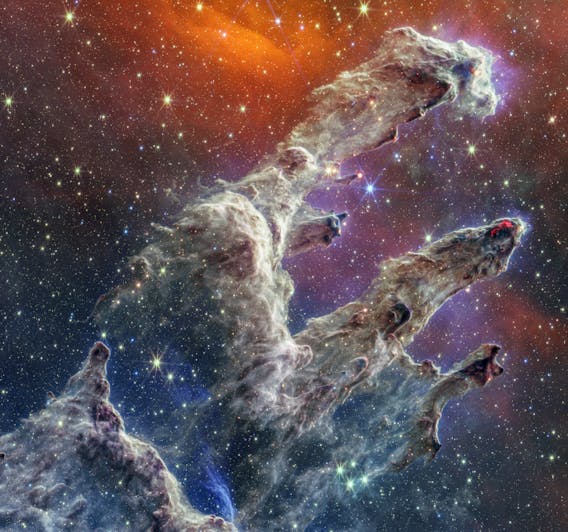Susana Widicus Weaver is an astrochemist at the University of Wisconsin-Madison. In her research, Dr. Weaver takes the spectra of molecules in a lab and uses that as a guide to look at them in space. The spectra are the amount of light emitted over a range of energies. Spectra can be produced for any energy of light, according to NASA. This then helps scientists understand how prebiotic chemistry starts.
Weaver has loved astronomy ever since she was a kid.
“My high school chemistry teacher told me all about the fields of cosmo chemistry and astrochemistry, and I realized that this is something I can actually do,” she said.
Weaver leads a research group called the Widicus Weaver Research Group. Eight graduate students along with staff scientists and undergraduates work with her. They all do laboratory work and some do observations.
Weaver and her team can use telescopes to observe star and planet-forming regions in space.
“For me, this is usually via radio astronomy, where we take spectra of the source and compare them to the molecular spectra we acquire in the lab,” said Weaver.
Spectroscopy has been widely regarded as a discovery from Isaac Newton in 1666 when he presented data indicating white light from the sun could be scattered into colors. Additionally, scientist Gustav Kirchhoff worked with Robert Bunsen at Heidelberg University around 1854. In 1860, they both were recognized for their creation of the spectroscope, which measures the spectrum of light.
Weaver described spectroscopy as shining different wavelengths of light at a molecular sample — “sometimes it absorbs and sometimes it doesn't.”
“If we trace the absorption where the intensity goes down as we shine it through the sample, we can actually assign those transitions and figure out the structure of the molecule,” she said.
Part of her work also involves rotational spectroscopy.
“Every molecule has its own unique 3D structure,” Weaver explained. “So they all rotate with different energies. You can use the spectrum as a guide to figure out what [structure] is and then we can see exactly those fingerprints in space, exactly which molecules are there and how much.”
“When they [molecules] spin, the speed at which they spin is determined by this structure. Think about a figure skater: If their arms are pulled in, they spin fast. If their arms are outstretched, they spin more slowly. Molecules are the same way”.
Scientists record the molecule’s response to different frequencies of light and how it spins.
“Since each molecule has a unique structure, it has a unique spectrum,” Weaver explained.
This may seem like a complex or intangible field to an ordinary person unfamiliar with spectroscopy. However, the “absolutely breathtaking” and “beautiful images” from the James Webb Space Telescope may offer more accessibility to people, according to Weaver.

Scientists can determine the makeup of a star’s atmosphere and temperature by observing which colors are absorbed and the prevalence of each wavelength, according to Harvard’s Center for Astrophysics.
“The other part of my research is to compare two models, where we put in all the starting material and the reactions as we understand them, and then we put in the physical evolution of the source and we try to understand how the chemistry changes as the star and planets [change],” Weaver said.
Observing different molecules at particular stages presents how the chemistry changes in that stage of star formation, said Weaver.
“The models actually give us a way to test what we see and predict something new. We can take the output of the model and predict new molecules and then go and use that [to determine] what we should look at next,” Weaver said.
A highlight of Weaver’s work revolves around the star-forming region called W3. This region is 6,200 light years away, according to Hershel Space Observatory.
“We've imaged what's called the dusty cocoon around a new star that's forming [in W3]. And we actually see the cocoon in the maps that we made, and we can see the organic molecules in the cocoon,” Weaver said. “We think that there's really interesting organic chemistry happening in that source. And so we're applying for follow-up observations and trying to understand.”
Spectroscopy can help us understand whether exoplanets have characteristics similar to those of Earth. Spectroscopy can help identify what other habitable worlds and solar systems may look like to make sense of whether or not we are alone in the universe.
“It may not look exactly like Earth. There's a lot of debate right now as to what's called a biosignature, meaning it's a sign that there's life on the planet and it's unclear what the clear-cut biosignatures are,” Weaver said.
By using spectroscopy to identify biosignatures, we can continue to gather clues about habitable worlds outside our solar system.
“We try not to limit too much on what we see on Earth,” Weaver said. “We're trying to keep all the possibilities open, so it's hard to narrow it down. We can certainly look for biosignatures like we would see on an Earth-like planet, and that's a place to start. But we're always trying to push the envelope outside of the box in that respect.”
As the Widicus Weaver group receives more information from the telescopes, their hope is the general public will grasp a better understanding of the astounding study of wavelengths.
Ava Menkes is a former managing editor for The Daily Cardinal. She previously served as the state news editor. She has covered multiple elections, legislative redistricting, healthcare and campus news. She also led 2024 presidential coverage and a project on news deserts. She previously interned with Wisconsin Watch and Isthmus, and will report with The Nation in 2025 on foreign policy and immigration. Follow her on Twitter at @AvaMenkes.






